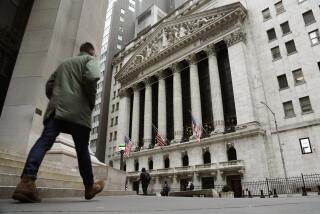Consumer Price Report Reassures Wall Street
- Share via
WASHINGTON — The nation’s most widely watched inflation measure showed that consumer prices rose at a quickened pace in September, but not at the market-rattling tear suggested by a different report last week, the government said Tuesday.
The news reassured investors that inflation is not out of control, and they reacted by pushing the Dow Jones industrial average up almost 90 points. Coupled with Monday’s gains, the Dow has recovered much of its 267-point loss in the wake of Friday’s worrisome report on producer prices.
The Labor Department said the consumer price index rose 0.4%, its biggest monthly jump since April, as Americans paid more for oil, tobacco and clothing.
But for a second month running, the rise in the overall rate was accompanied by the smallest annual increase in more than three decades in the so-called core rate, which strips away sometimes-distorting food and energy prices. And the increase stood in sharp contrast to an unexpected 1.1% jump in the producer price index, which set financial markets tumbling Friday.
The consumer price index keeps tabs on what Americans pay for a broad range of goods and services used in daily life, including imports. The producer price index measures only domestic goods that companies sell each other in the course of business. Although consumer prices are supposed to follow in lock-step behind producer prices, they often do not.
“We still have healthy growth and low inflation,” Merrill Lynch chief economist Bruce Steinburg said. “There is no evidence of a pickup in inflation pressures in the U.S.”
“It may feel a little less like Nirvana, but the fundamental outlook hasn’t changed,” said William Cheney, chief economist with John Hancock Mutual Life Insurance Co. in Boston.
Tuesday’s report showed that consumer prices were 2.6% higher this September than in September 1998, their biggest 12-month increase since March 1997, according to the Labor Department.
That increase was hardly as dramatic as the comparable 3.2% jump in producer prices announced Friday. But it probably would have been enough under ordinary circumstances to spur fears that economic growth was finally producing the long-feared pickup in prices.
However, analysts cited a series of one-time jumps behind last month’s numbers and a string of separate reports Tuesday suggesting that growth may finally be cooling.
For example, they traced much of this year’s increase in the consumer price index to escalating energy prices, which they said were unlikely to turn into a generalized rise in prices.
Overall, energy prices rose 1.7% in September, their third straight month of sharp increases, according to the Labor Department. Gasoline prices rose 2.6% while home heating oil climbed 6.2%, its biggest jump in three years. However, Steinburg said, “these are not likely to track through” into other prices.
Much of the increase in both the overall inflation rate and the core rate was due to a huge jump in tobacco prices, which were up 6.5% last month, reflecting the industry’s $246-billion settlement of smoking liability cases with the states. Analysts said that this too was a one-time increase and not evidence of a general trend.
Minus energy and food prices, core inflation rose 0.3% for the month and 2% for the previous year. That annual rate was nearly identical to August’s 1.9% and, together, the two months posted the lowest core inflation since mid-1966, according to Labor Department analysts. Minus tobacco prices, the core rate in September would have been an even lower 0.2%.
A separate Commerce Department report showed Tuesday that housing construction starts tumbled 3.2% in September to a seasonally adjusted annual rate of 1.62 million.
Although part of the drop was the result of Hurricane Floyd and a shortage of workers and material, analysts said part was due to higher interest rates, suggesting that economic growth may be slowing.
Even if it is, however, Steinburg and others predicted the Federal Reserve will push up interest rates when its policymaking body meets Nov. 16.
“The inflation numbers are starting to tend upward, not seriously but enough that the Fed will probably act,” said Donald Ratajczak, economic forecasting director at Georgia State University in Atlanta. Asked to pick between the drastically different inflation signals sent by Friday’s producer price index and Tuesday’s consumer price index, most economists sided with the consumer measure.
“The PPI is not very good at forecasting the CPI or inflation,” said Stephen G. Cecchetti, an economist at Ohio State University and former research director at the Federal Reserve Bank of New York. By measuring nothing but goods that businesses sell to one another, the producer index misses service and labor costs and imports and therefore accounts for only about 20% of the economy, Cecchetti said.
By contrast, the consumer index cuts across all these areas, he said.
In addition, the CPI has a direct effect on everything from Social Security and labor contract cost-of-living adjustments to how much people pay in income taxes.
*
SOCIAL SECURITY
Beneficiaries will see a 2.4% cost-of-living increase starting Jan. 1. C15
(BEGIN TEXT OF INFOBOX / INFOGRAPHIC)
INFLATION WATCH
Inflation fears eased as a report on consumer prices found modest gains. C1
*
Producer price index +3.2%
*
Consumer price index +2.6%
*
More to Read
Inside the business of entertainment
The Wide Shot brings you news, analysis and insights on everything from streaming wars to production — and what it all means for the future.
You may occasionally receive promotional content from the Los Angeles Times.










